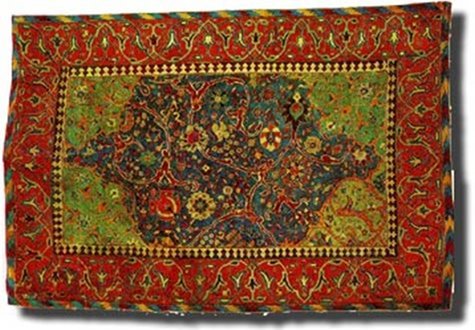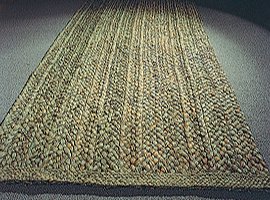
Turkish Carpet
Europe Before the Carpet
Historic sources indicate that the earliest floor covering in Europe consisted of rushes (various stiff marsh plants). Rushes were scattered over the floor and renewed from time to time. Later, rushes were woven into mats and widely used in Europe in this form. This practice continued up to the second half of the 15th century.


Wild Rushes & Rush Mat
Desiderius Erasmus (1466-1536) revealed that these rushes were sometimes left too long that he condemned their use.
The floors are, in general, laid with white clay, and are covered with rushes, occasionally renewed, but so imperfectly that the bottom layer is left undisturbed, sometimes for twenty years, harbouring expectoration, vomiting, the leakage of dogs and men, ale droppings, scraps of fish, and other abominations not fit to be mentioned. Whenever the weather changes a vapour is exhaled, which I consider very detrimental to health.

A picture in the Book of Hours in the Chateau at Chantilly entitled, Tres riches Heures du Duc de Berry
depicts the Duke (1340-1416) seated at a table under which the
floor is covered with rush matting.
The Muslim Carpet & Europe
During the Crusades, Europeans came into contact with Islamic carpets. Realizing that they were vastly superior to rush mats, Muslim carpets notably those of the Turks, soon became luxury trade items.
The earliest recorded English contact with Muslim carpets came in the 12th century when the grandson of William the Conqueror who lived in the Abbey of Cluny gave an Islamic carpet to an English church.
In France, Muslim carpets were known much earlier and were particularly popular at the time of Louis IX (1215-70)
under the name tapis Sarrasinois
. In 1277, this popularity resulted in trade privileges for this tapis in Paris.
The famous Muslim geographer, Muhammad al-Idrisi (c.1096 - 1166), revealed that woolen carpets were produced in the 12th century in Chinchilla and Murcia (both now in Spain) and were exported all over the world.
In addition to these historical facts, there is another source which provides credible evidence enabling us to evaluate the extent of use and the position of the Muslim carpet in Europe. The study of paintings made in late medieval period supplied considerable information on how and where these carpets were used and how they were regarded.
The earliest occurrences of carpets in European paintings go back to the early 1300s, when portraits of important people from Italy, France, Germany, Holland and Belgium illustrated the luxurious usage of these carpets. In Italy, the earliest evidence of carpets is traced to the end of 12th century, appearing in increasing number of paintings of this period, either below the throne of the Madonna, on the floor of sacred rites, or hanging from windows of homes on feast days.
By the 15th century, carpets gained more popularity as they began to appear in documents showing that they were used as table carpets (tapedi de tavola) and desk carpets (tapedi da desco). These were both Damascus carpets (tapedi damaschini) and Cairo carpets (tapedi ciaiarini), which invaded the trading markets of Venice.
In Renaissance paintings, one can easily notice a considerable increase in the popularity of Muslim carpets, particularly the Turkish and Persian makes. In the 15th and 16th centuries, growing trade relations and increasing prosperity of Europe resulted in more importation of Muslim artistic and luxurious goods as the educated and wealthy of European society started to experience a more comfortable life.
